Chengdu Wuhou Shrine Museum is located at No. 231 Wuhouci Street, Wuhou District, Chengdu City, Sichuan Province. It is the only temple in China where emperors and ministers are jointly enshrined. It is also a national key cultural relic protection unit and a national 4A-level tourist attraction. Covering an area of approximately 150,000 square meters, the scenic area consists of three parts: the Three Kingdoms Cultural Heritage Protection Zone, the Three Kingdoms Cultural Experience Zone, and the Jinli Folk Custom Zone. The existing buildings were reconstructed in the 11th year of the Kangxi reign of the Qing Dynasty (1672) and retain the architectural style of the late Ming and early Qing dynasties. With red walls against bamboo shadows and dense ancient cypresses, it possesses extremely high historical and cultural value as well as artistic appreciation value.
Historical and Cultural Background
Wuhou Shrine was first built in the 3rd year of the Zhangwu reign (223 AD) to commemorate Liu Bei, Emperor Zhaolie of the Shu Han Dynasty, and Zhuge Liang, the Prime Minister. Initially, it was adjacent to Liu Bei's Huiling Mausoleum. During the Tang Dynasty, Wuhou Shrine had already become a famous scenic spot, and Du Fu once wrote the poem line: "Where to find the Prime Minister's ancestral temple? Beyond the Brocade Official City, cypresses stand dense." In the early Ming Dynasty, Wuhou Shrine was merged into Liu Bei Temple, forming a pattern of joint enshrinement of the emperor and his minister. At the end of the Ming Dynasty, the temple was destroyed in wars; it was reconstructed in the 11th year of the Kangxi reign of the Qing Dynasty (1672), forming the scale of the existing buildings.
In 1961, Wuhou Shrine was announced by the State Council as one of the first batch of national key cultural relic protection units. In 1984, Chengdu Wuhou Shrine Museum was established, and in 2008, it was rated as a national 4A-level tourist attraction. The scenic area preserves a large number of cultural relics of the Shu Han Dynasty, such as Liu Bei Hall, Zhuge Liang Hall, and Huiling Mausoleum, as well as numerous stone inscriptions, plaques, and couplets. It is an important site for the study of the Three Kingdoms culture.
Major Scenic Spots
Liu Bei Hall
Liu Bei Hall is one of the main buildings of Wuhou Shrine. Inside the hall, there is a gilded statue of Liu Bei, 3 meters tall, wearing a dragon robe and holding a jade tablet, with a solemn demeanor. On both sides of the hall, there are 28 statues of famous generals of the Shu Han Dynasty, including Guan Yu and Zhang Fei, each with a distinct and vivid expression. Hanging in the hall is a plaque inscribed with "Ye Shao Gao Guang" (Inheriting the Achievements of Gaozu and Guangwu), which means that Liu Bei's achievements inherited those of Liu Bang, Emperor Gaozu of the Han Dynasty, and Liu Xiu, Emperor Guangwu of the Han Dynasty.
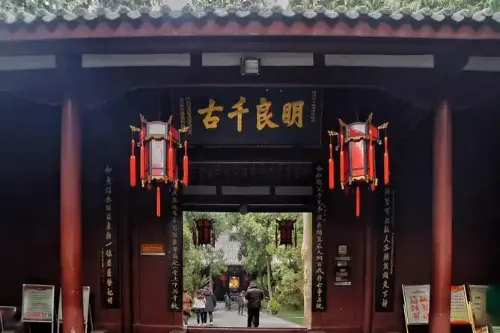

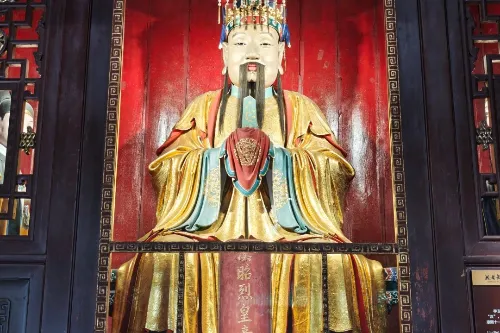
Zhuge Liang Hall
Also known as Wuhou Shrine, Zhuge Liang Hall is located behind Liu Bei Hall and is the main place for worshipping Zhuge Liang. Inside the hall, there is a gilded statue of Zhuge Liang, 2.8 meters tall, holding a feather fan and exuding an elegant demeanor. On both sides of the hall, there are statues of his son Zhuge Zhan and grandson Zhuge Shang. Hanging in the hall is a plaque inscribed with "Ming Chui Yu Zhou" (Fame Spanning the Universe). On both sides of the hall, there is a couplet: "Three visits to the thatched cottage laid out strategies for the world; two dynasties' prosperity relied on the loyal heart of the old minister," which highly summarizes Zhuge Liang's life.
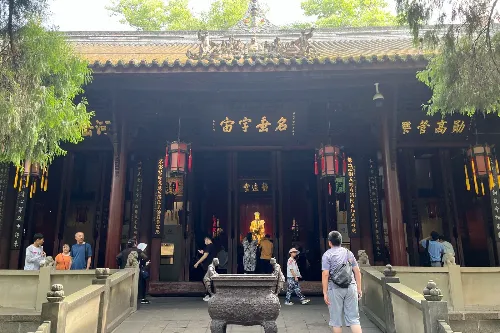

Huiling Mausoleum
Huiling Mausoleum is the tomb of Liu Bei, located on the west side of Wuhou Shrine. It is the only preserved imperial mausoleum from the Three Kingdoms period. The mausoleum is 12 meters high, with a circumference of 180 meters, and is in the shape of an inverted bucket. The tomb mound is surrounded by a wall. In front of the tomb stands a stele inscribed with "Tomb of Emperor Zhaolie of the Han Dynasty," which was erected in the 53rd year of the Qianlong reign of the Qing Dynasty (1788). Adjacent to Wuhou Shrine, Huiling Mausoleum forms a pattern of "integrated temple and tomb."
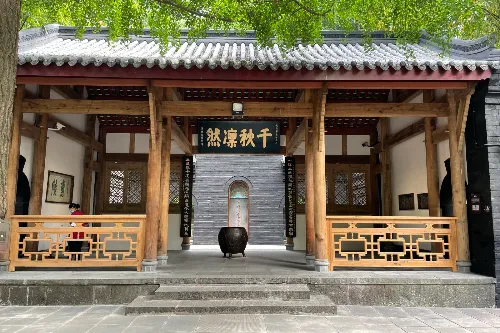
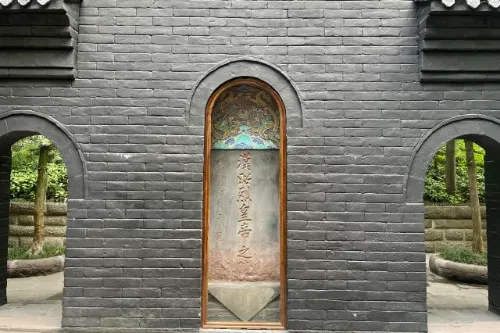
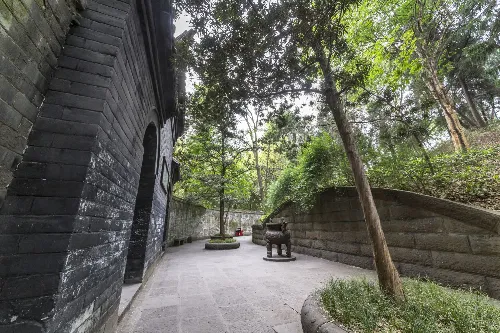
Sanyi Temple
Originally located on Tidujie Street in Chengdu, Sanyi Temple was built to commemorate the "Oath of the Peach Garden" among Liu Bei, Guan Yu, and Zhang Fei. It was relocated entirely to Wuhou Shrine in 2003. Inside the temple, there are statues of Liu Bei, Guan Yu, Zhang Fei, as well as famous generals of the Shu Han Dynasty such as Zhao Yun and Ma Chao. The architectural style of Sanyi Temple is typical of Western Sichuan residential architecture, featuring green tiles, white walls, and elaborately carved beams and painted rafters.
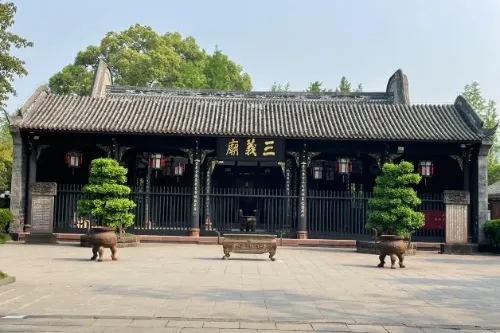
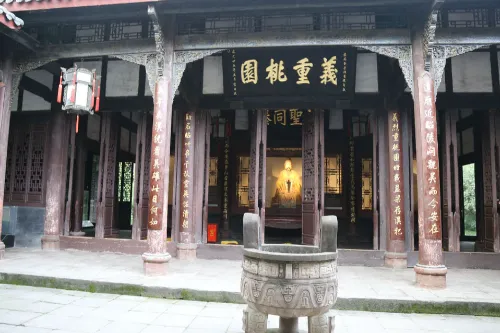
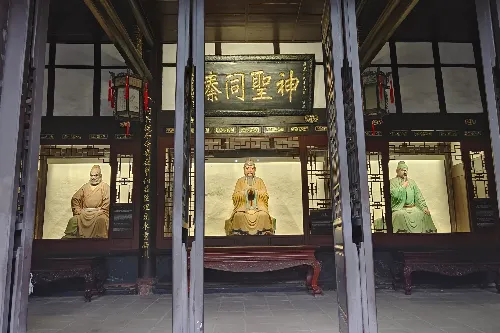
Red Wall Lane
Red Wall Lane surrounds both sides of the entrance to Huiling Mausoleum. This lane, with red walls and bluestone pavement, leads to the resting place of an emperor who has been asleep for over 1,700 years. Along the lane, you can see red courtyard walls on both sides, with dense bamboo growing outside.
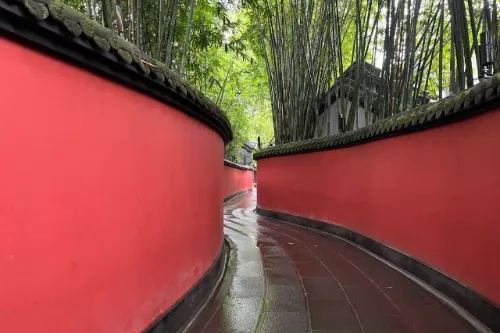
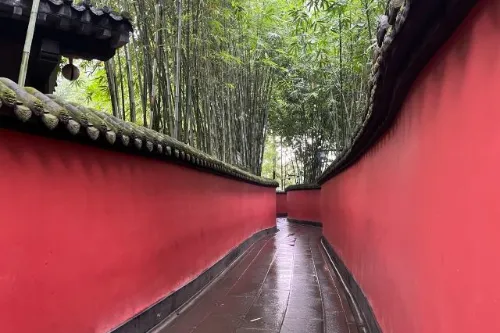
Han Zhaolie Temple
The main gate stands open in the middle. Looking up, the four golden characters "Han Zhaolie Temple" on the scarlet plaque come into view, inspiring a sense of respect. On the left and right sides in front of the gate, there is a stone lion from the Ming Dynasty, adding a great deal of dignity to the temple. Outside the central axis of the gate, there is a screen wall, simple and elegant.
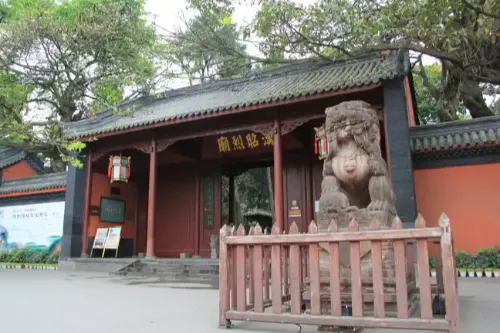
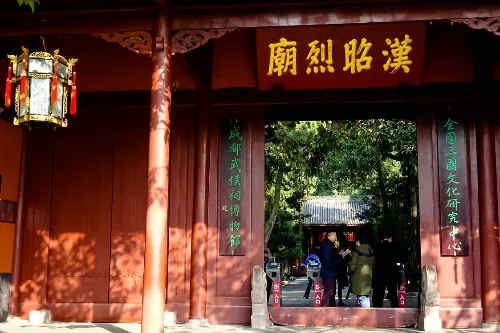
Tang Dynasty Stele
Its full name is "Stele of the Ancestral Temple of Zhuge Liang, Prime Minister of Shu," with a long history of over 1,200 years. In the 4th year of the Yuanhe reign of Emperor Xianzong of the Tang Dynasty (809 AD), Wu Yuanheng, the then Jiedushi (military governor) of Jiannan Xichuan, led 27 subordinates to pay homage to Wuhou Shrine. He ordered Pei Du, the Secretary of the Jiedushi Mansion, to write an essay and erect a stele to express his admiration for Zhuge Liang and inspire future generations. After the essay was completed, Liu Gongchuo wrote the calligraphy, and Lu Jian was in charge of the engraving. Due to the exquisite essay, calligraphy, and engraving, the Tang Dynasty Stele is known as the "Stele of Three Perfections."
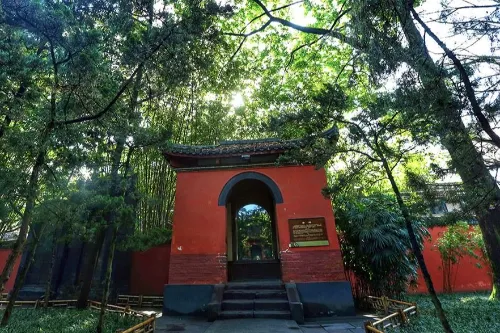
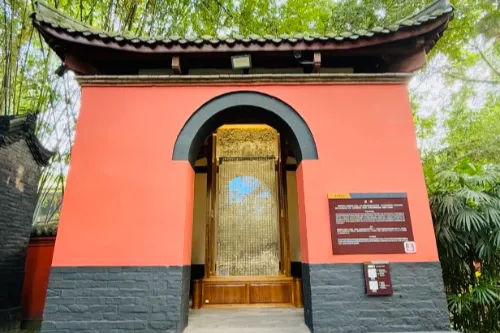
Civil Officials and Military Generals Corridors
Inside the east and west corridors in front of Liu Bei Hall, there are 28 statues of civil officials and military generals of the Shu Han Dynasty. The east corridor is called the Civil Officials Corridor, led by Pang Tong, known as "Phoenix Chick," with a total of 14 statues. The west corridor is the Military Generals Corridor, headed by Zhao Yun, who was both wise and brave, also with 14 statues. In front of each statue, there is a stone tablet introducing the life story of the figure.


Recommended Tour Route
Recommended Tour Route: Main Gate → Huiling Mausoleum → Liu Bei Hall → Zhuge Liang Hall → Sanyi Temple → Jieyi Tower → Jinli Ancient Street. Starting from the main gate of the scenic area, this route first takes you to visit Huiling Mausoleum (Liu Bei's tomb), then follows the central axis to visit Liu Bei Hall and Zhuge Liang Hall in sequence to learn about the historical stories of the emperor and ministers of the Shu Han Dynasty. Next, go to Sanyi Temple to feel the sworn brotherhood of Liu Bei, Guan Yu, and Zhang Fei. Finally, watch a Sichuan Opera performance at Jieyi Tower, visit Jinli Ancient Street, and experience the folk culture of Western Sichuan. The entire journey takes about 2-3 hours, allowing you to fully appreciate the historical and cultural charm of Wuhou Shrine and the folk customs of Jinli.
Travel Tips
- It is recommended to visit in spring (March-May) or autumn (September-November). During these periods, the climate in Chengdu is mild, making it suitable for outdoor activities.
- Reserve tickets in advance through the official WeChat public account of the scenic area to avoid queuing during holidays.
- Hire a scenic area guide (approximately 100 yuan per session) or rent an audio guide (20 yuan per unit) to gain an in-depth understanding of the Three Kingdoms culture and the history of Wuhou Shrine.
- After visiting Wuhou Shrine, you can go to Jinli Ancient Street to taste Chengdu's characteristic snacks and buy handicrafts as souvenirs.
- Jinli Ancient Street is brightly lit at night; you can arrange a visit in the evening to experience the charm of the ancient street's night scenery.
Notes
- Smoking and littering are prohibited within the scenic area; please keep the environment clean and tidy.
- When visiting cultural relics and historical sites, do not touch or climb on them to avoid damaging the cultural relics.
- There are many tourists during holidays; please take good care of your personal belongings and look after the elderly and children.
- Jinli Ancient Street has a large flow of people and the ground may be slippery; it is recommended to wear non-slip shoes.
- Do not use a flash when taking photos to avoid causing damage to cultural relics.
Transportation
- Bus: Take Bus No. 1, 57, 334, 335, G74, etc., and get off at "Wuhou Shrine Station" to reach the destination directly.
- Metro: Take Metro Line 3, get off at "Gaoshengqiao Station", and walk for about 10 minutes to arrive.
- Self-driving: There is a parking lot in the scenic area, located at No. 231 Wuhouci Street, with a parking fee of approximately 10 yuan per hour.
Opening Hours
The scenic area is open year-round, with opening hours from 08:00 to 20:00 (admission stops at 19:30). During legal holidays and major events, the opening hours may be adjusted; please refer to the official announcement of the scenic area for details. Jinli Ancient Street is open 24 hours a day and can be visited free of charge.
Tickets
The ticket price is 50 yuan per person.
You can search for the official WeChat public account of the scenic area "成都武侯祠" to obtain the latest updates or purchase tickets online.
Online Booking
Click here to jump to the Trip.com ticketing platform for ticket purchase.


